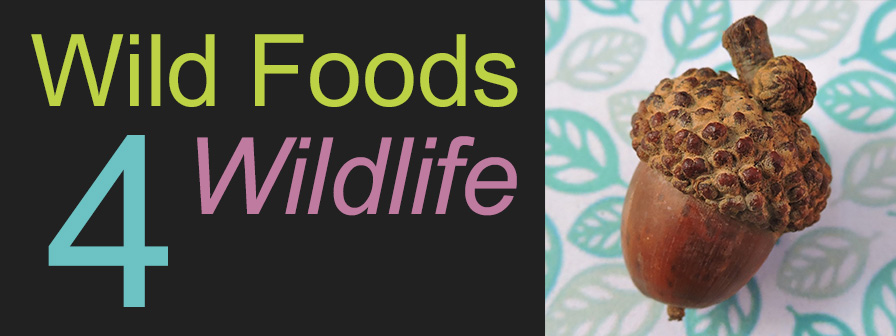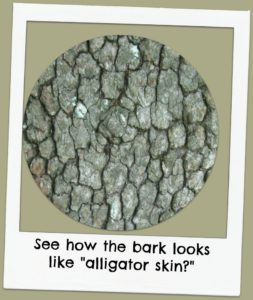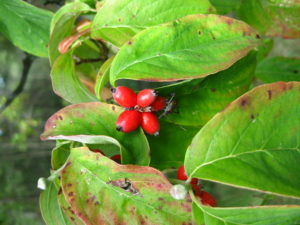Name: Flowering Dogwood
Botanical Name: Cornus florida
Form: small tree
Parts Used: berries, browse
Citation: Guenther, K. (2017, January 12) Flowering dogwood as wildlife food [Web log post.] Retrieved: readers supply the date, from http://wildfoods4wildlife.com
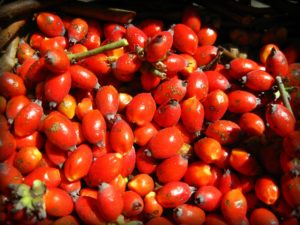
Getting Started
This tree’s fruit ranks #3 on the Favorite Fruits List of valuable wild fruits for our fauna. Thirty different animals eat these berries and thirteen species of birds use dogwood berries in especially high quantities when available. That’s a valuable food, and one that is easy for beginners to identify and collect!
It’s no slouch as a browse favorite either, ranking #13 on the Best Browse List.
Dogwoods are well-known trees. Flowering dogwood is Virginia’s state tree. Some dogwood species are shrubby in form, meaning they have multiple trunks. Interesting aside, the Tupelo (or Gum) genus (Nyssa), falls under the larger Dogwood family umbrella and is another good wildlife food.
Dogwood’s bright red berries are relatively easy to reach and the tree is easy to identify and common in many folks’ yards.
Cornaceae ( Dogwood family)
Cornus (Dogwood genus)
| Common name | Virginia Cornus Species | Origin | Rare Plant Status |
| alternateleaf dogwood | C. alternifolia | native | rare in some states (not Virginia) |
| silky dogwood | C. amomum | native | rare in some states (not Virginia) |
| bunchberry dogwood | C. canadensis | native | Globally secure but critically imperiled in Virginia |
| flowering dogwood | C. florida | native | rare in some states (not Virginia) |
| Asian or kousa dogwood | C. kousa | non-native | not rare |
| silky dogwood | C. obliqua | native | Globally secure but critically imperiled in Virginia |
| gray dogwood | C. racemosa | native | not rare |
| roundleaf dogwood | C. rugosa | native | Globally secure but critically imperiled in Virginia |
| redosier dogwood | C. stolonifera Michaux | native | not rare |
| stiff dogwood | C. stricta | native | not rare |

Key Features to Look For
In addition to the identification guide of your choice, here are a couple of features you should see on this tree:
- Opposite leaves and branches, uplifting branches, leaves hang vertically downwards
- Red, shiny, oval berries feel a little waxy, in compact clusters
- “Alligator bark” on older trees
- Understory size tree, 20-30 feet tall
- Large white “flowers” with a notch “bite” out of the center end of each “petal”
A few words about the bark. On an older dogwood, the bark breaks up into blocks, often described as “alligator bark.” Some other species of trees have this as well, notably persimmon and black gum. But, bark patterns can help be an identifier.
Risks
None indicated for animals.
About this Species
This popular small understory tree can be found growing naturally in forests and woods, and is planted intentionally in many parks and yards. It is easy to identify and easy to collect fruit from. Unfortunately, it is suffering from Dogwood Anthracnose Fungus, a new fungal disease that especially affects trees in moist or shady conditions.
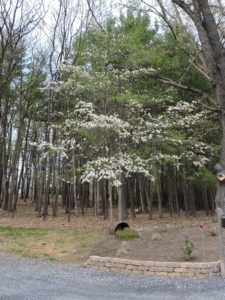
Flower Description: The inflorescence—what seems to be the “flower”— is large (about 2+ inches diameter (6-7 cm) white and showy, but the four white flower “petals” are actually modified leaves called bracts. On the tips of these white to pinkish bracts, it looks like something took a small bite out of the bract. The actual greenish-yellow flowers are in the center of the these bracts and each of the flower ovules will in fall turn into a red berry grouped in a bunch— hence another name for a related tree— bunchberry. Most accurately, bunchberry refers only to the species C. Canadensis.
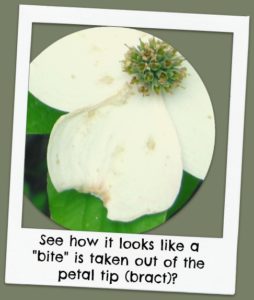
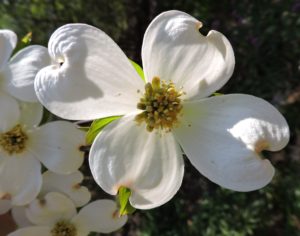
Leaf Description: My mental search image for a dogwood leaf is that the leaf color is a mixture of green and maroon colors much of the growing season. The leaves appear to fold upwards slightly along the center axis of the leaf and the veins curve to run parallel to the leaf edges. Dogwoods are one of the relatively few trees with opposite leaves along the stem (except C. alternafolia which has alternate branching structure indicated right in its name!). The leaves are often wavy along the edges, but not lobed or serrated.
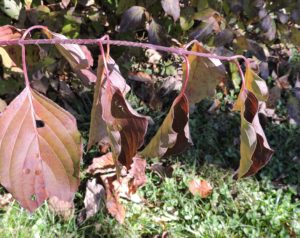
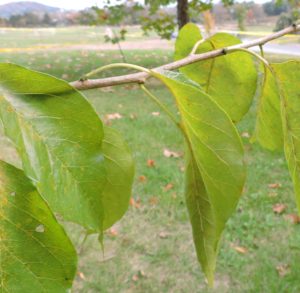
Fruit Size: The dogwood fruit (a drupe) is an oval shiny red fruit that feels waxy on the outside. Up to 6-7 of these drupes form together from the mature flower ovaries. They ripen in October and form a bunch at what used to be the center of the spring bloom.
The drupe is about 7/16 inch (1 cm) long. The pulp inside is a golden color. The single seed is pinkish-yellow with faint lines running lengthwise in the seed.
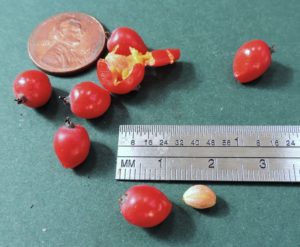
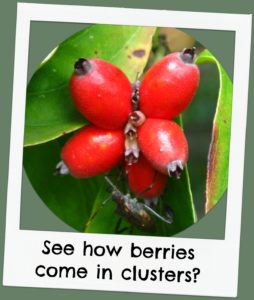
At other times of year, you can see next year’s flower bud forming, the recognizable “turbans” of the dogwood bud.
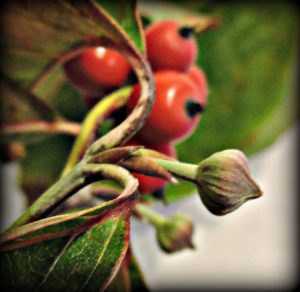
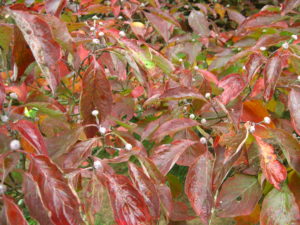
Harvest
| Jan | Feb | Mar | Apr | May | Jun | Jul | Aug | Sep | Oct | Nov | Dec | ||||||||||||||
|---|---|---|---|---|---|---|---|---|---|---|---|---|---|---|---|---|---|---|---|---|---|---|---|---|---|
| winter | winter | late winter | early spring | spring | late spring | early summer | summer | late summer | early fall | fall | late fall | ||||||||||||||
| fruit | x | x | x | x | |||||||||||||||||||||
| browse | x | x | x | x | x | x | x | x | x | x | x | ||||||||||||||
Does this lend itself to being a good enrichment item? Maybe. If you already have a reason to trim back a dogwood’s branches at the time the drupes are on the tree, the branches or twigs with leaves and fruits can be installed in an enclosure taking care not to knock the fruit off while handling the limb. But dogwood trees or shrubs are small and cannot take frequent limb harvesting. Late fall is the best time to prune a dogwood.
Harvesting Fruit
Mature drupes (berries) turn shiny bright red, and you can easily hand pick off the tree. Ripe fruit should pull off with ease and the seed can be squeezed out using your fingers. If you find the drupe stays firm on the tree or is so hard that you have to cut the seed out, then the fruit is not ripe. All the fruit usually ripens pretty much at the same time and can persist on the tree up to two months.
How to Store Prepared Fruit: Commercial berry containers are great for storing fruit because the rigid plastic keeps fruit from getting crushed and they also have small holes in them which control the humidity in the container. This slows the fruit from drying out too quickly, but allows air circulation to reduce molding.
Dogwood berries keep well in re-used commercial berry containers in the refrigerator for one to two weeks.
It is ideal to use this fruit fresh, so if at all possible, use them fresh. Frozen fruits just come out dark and mushy, but if you really need to freeze them you can, knowing that the texture will be greatly compromised upon thawing. Nutrients will be preserved. Spread berries in a single layer on a cookie sheet and place in freezer for 1 day. Once frozen, repackage them into zipping freezer baggies (3 mils or thicker) or glass jars to keep them from drying out, remove as much air as possible from the baggie, label and store in freezer until needed—no more than 1 year. Avoid freezing, thawing and refreezing as might happen in a door of a freezer.
See more detailed instructions under the tab Storing Fruit.
Harvesting Browse
Dogwood is one of the favorite browse cuttings for deer.
Browse as a term used on this website refers to the twigs and small branches, with or without leaves or needles, of trees, shrubs, vines and other woody stemmed plants. Browse can also refer to bark, for the animals that gnaw on bark.
Small trees cannot tolerate very much cutting and survive. The best time to harvest browse for the health of the tree is late fall to winter, but that may not be when you need the browse. The best limbs to remove are ones that rub together and cause abrasions that can make the tree vulnerable to insect damage. Or, cut branches that are overcrowded or hang low to the ground. Prune branches back to the base where the branch meets the trunk to minimize future insect damage to the tree.
Dip pruning shears into a bleach water solution (1:3) to minimize transferring tree diseases from one tree to the next.
Place the cut end of the browse in a bucket of water as soon as possible after cutting- ideally taking a bucket of what with you as you harvest because the branch will start to close itself off the instant it is injured. Then keep them in water as much as possible prior to feeding, which ideally means even during transport. And keep cut browse in the shade.
Browse cuttings are best fed to animals right away, they do not store well for more than a day before the leaves start to wilt and dry out, especially if it is hot. Read more, at Cutting Browse.
Other Dogwood Species: Kousa or Asian Dogwood (C. kousa) is a common non-native ornamental dogwood planted by landscapers. Its tree form and leaf is easily recognizable as a dogwood species, but the berry is totally different from flowering dogwood. The berries are the size of a bing cherry and look to me like pink soccer balls. They ripen in September and October. Ripe fruit falls from the tree and can be collected off the ground while plump and pink. They are known to be eaten by squirrels and crows.
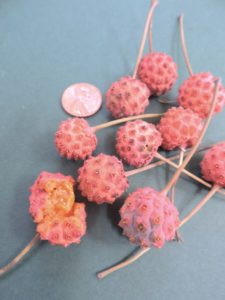
Rare Species in Virginia
Do you live in one of these Virginia counties? If so, be aware that there are some species near you that may be threatened or endangered. Do more research to make sure you are identifying your target species correctly and not harvesting a threatened species!
| County in Virginia | Species |
| Albemarle | bunchberry dogwood |
| Augusta | roundleaf dogwood |
| Bath | bunchberry dogwood |
| Botetourt | silky dogwood |
| Craig | roundleaf dogwood |
| Fairfax | silky dogwood |
| Frederick | silky dogwood |
| Highland | bunchberry dogwood |
| Highland | roundleaf dogwood |
| Giles | roundleaf dogwood |
| Loudon | silky dogwood |
| Madison | roundleaf dogwood |
| Page | roundleaf dogwood |
| Rappahannock | roundleaf dogwood |
| Rockingham | bunchberry dogwood |
| Rockbridge | roundleaf dogwood |
| Scott | silky dogwood |
| Shenandoah | roundleaf dogwood |
Feed Dogwood to:
dogwood | (Cornus spp.) | browse/bark |
|---|---|---|
Deer, White-tailed | Odocoileus virginianus | strong preference |
Beaver, American | Castor canadensis |
|
Chipmunk, Eastern | Tamias striatus |
|
Cottontail, Eastern | Sylvilagus floridanus |
|
Elk, Rocky Mountain | Cervus elaphus |
|
Hare, Snowshoe | Lepus americanus |
|
Moose | Alces americanus |
|
Raccoon, Northern | Procyon lotor |
|
Skunk, Striped | Mephitis mephitis |
|
Squirrel, Eastern Fox | Sciurus niger |
|
Squirrel, Eastern Gray | Sciurus carolinensis |
|
dogwood | (Cornus spp.) | fruit |
Bear, American Black | Ursus americanus |
|
Beaver, American | Castor canadensis |
|
Chipmunk, Eastern | Tamias striatus |
|
Cottontail, Eastern | Sylvilagus floridanus |
|
Deer, White-tailed | Odocoileus virginianus |
|
Fox, Eastern Gray | Urocyon cinereoargenteus |
|
Hare, Snowshoe | Lepus americanus |
|
Mouse, Common White-footed | Peromyscus leucopus |
|
Raccoon, Northern | Procyon lotor |
|
Skunk, Spotted | Spilogale putorius |
|
Skunk, Striped | Mephitis mephitis |
|
Squirrel, Eastern Fox | Sciurus niger |
|
Squirrel, Eastern Gray | Sciurus carolinensis |
|
Vole, Red-backed | Myodes spp., Clethrionomys spp. |
|
Voles, various spp. | various species |
|
Bluebird, Eastern | Sialia sialis | strong preference |
Cardinal, Northern | Cardinalis cardinalis | strong preference |
Flicker, Northern | Colaptes auratus | strong preference |
Grosbeak, Evening | Coccothraustes vespertinus | strong preference |
Kingbird, Eastern | Tyrannus tyrannus | strong preference |
Robin, American | Turdus migratorius | strong preference |
Thrush, Gray-cheeked | Catharus minimus | strong preference |
Thrush, Hermit | Catharus guttatus | strong preference |
Thrush, Swainson's | Catharus ustulatus | strong preference |
Thrush, Wood | Hylocichla mustelina | strong preference |
Vireo, Red-eyed | Vireo olivaceus | strong preference |
Blackbird, Rusty | Euphagus carolinus |
|
Catbird, Gray | Demetella carolinensis |
|
Chat, Yellow-bellied | Icteria virens |
|
Crow, American | Corvus brachyrhynchos |
|
Crow, Fish | Corvus ossifragus |
|
Finch, Purple | Carpodacus purpureus |
|
Flycatcher, Acadian | Empidonax virescens |
|
Flycatcher, Alder | Empidonax alnorum |
|
Flycatcher, Great-crested | Myiarchus crinitus |
|
Flycatcher, Least | Empidonax minimus |
|
Flycatcher, Willow | Empidonax traillii |
|
Grackle, Common | Quiscalus quiscula |
|
Grosbeak, Blue | Guiraca caerulea |
|
Grosbeak, Rose-breasted | Pheucticus ludovicianus |
|
Jay, Blue | Cyanocitta cristata |
|
Junco, Dark-eyed | Junco hyemalis |
|
Kinglet, Ruby-crowned | Regulus calendula |
|
Longspur, Lapland | Calcarius lapponicus |
|
Mockingbird, Northern | Mimus polyglottos |
|
Oriole, Baltimore | Icterus galbula |
|
Sapsucker, Yellow-bellied | Sphyrapicus varius |
|
Sparrow, House | Passer domesticus |
|
Sparrow, Song | Melospiza melodia |
|
Sparrow, White-throated | Zonotrichia albicollis |
|
Starling, European | Sturnus vulgaris |
|
Swallow, Barn | Hirundo rustica |
|
Swallow, Tree | Tachycineta bicolor |
|
Tanager, Summer | Piranga rubra |
|
Thrasher, Brown | Toxostoma rufum |
|
Thrush, Bicknell's | Catharus bicknelli |
|
Titmouse, Tufted | Baeolophus bicolor |
|
Towhee, Eastern | Pipilo erythrophthalmus |
|
Veery | Catharus fuscescens |
|
Vireo, Blue-headed | Vireo solitarius |
|
Vireo, Philadelphia | Vireo philadelphicus |
|
Vireo, Warbling | Vireo gilvus |
|
Vireo, White-eyed | Vireo griseus |
|
Bobwhite, Northern | Colinus virginianus |
|
Duck, Wood | Aix sponsa |
|
Grouse, Ruffed | Bonasa umbellus |
|
Grouse, Sharp-tailed | Tympanuchus phasianellus |
|
Pheasant, Ring-necked | Phasianus colchicus |
|
Turkey, Wild | Meleagris gallopavo |
|
Book References
Elpel, T.J. (2013) Botany in a Day (APG). Pony, Montana: Hops Press, LLC.
Martin, A.C., Zim, H.S., Nelson, A.L. (1951). American Wildlife and Plants: A Guide to Wildlife Food Habits. New York: Dover Publications.
Scott, M. (2013). Songbird Diet Index. National Wildlife Rehabilitators Association, St. Cloud, MN.
Townsend, J. F. (2015, April) Rare Plants Natural Heritage Technical Report 15-10. (Unpublished Report) Richmond, Virginia: Virginia Department of Conservation and Recreation, Division of Natural Heritage.
Virginia Department of Forestry (2010). Common Native Trees of Virginia: Tree Identification Guide
Online References
Coladonato, Milo. 1994. Cornus alternifolia. In: Fire Effects Information System, [Online]. U.S. Department of Agriculture, Forest Service, Rocky Mountain Research Station, Fire Sciences Laboratory (Producer). Available: http://www.fs.fed.us/database/feis/ [2016, December 5].
Coladonato, Milo. 1993. Cornus racemosa. In: Fire Effects Information System, [Online]. U.S. Department of Agriculture, Forest Service, Rocky Mountain Research Station, Fire Sciences Laboratory (Producer). Available: http://www.fs.fed.us/database/feis/ [2016, December 5].
Gucker, Corey. 2012. Cornus sericea. In: Fire Effects Information System, [Online]. U.S. Department of Agriculture, Forest Service, Rocky Mountain Research Station, Fire Sciences Laboratory (Producer).
Available: http://www.fs.fed.us/database/feis/plants/shrub/corser/all.html [2016, December 5].
Tirmenstein, D. A. 1991. Cornus florida. In: Fire Effects Information System, [Online]. U.S. Department of Agriculture, Forest Service, Rocky Mountain Research Station, Fire Sciences Laboratory (Producer). Available: https://www.fs.fed.us/database/feis/plants/shrub/corflo/all.html [December 5]
USDA, NRCS. 2015. The PLANTS Database (http://plants.usda.gov, 24 November 2015). National Plant Data Team, Greensboro, NC 27401-4901 USA.
Virginia Botanical Associates. (Accessed November 2015). Digital Atlas of the Virginia Flora (http://www.vaplantatlas.org). c/o Virginia Botanical Associates, Blacksburg.
